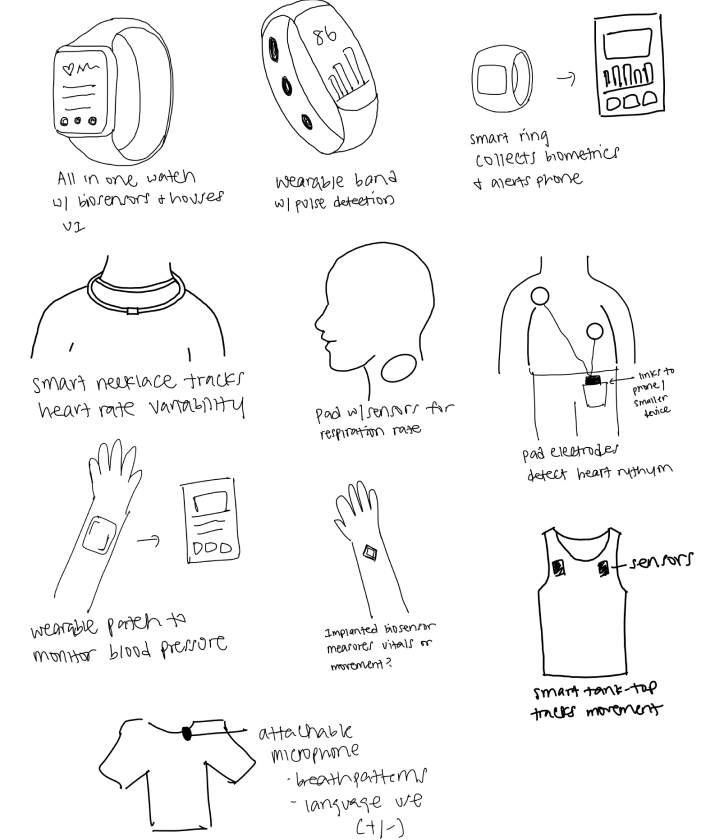Pulse of Mind - POM
DISCOVER | DEFINE | DEVELOP | DELIVER
Overview: I designed a speculative smart watch and corresponding mobile application that leverages AI to analyze behavioral inputs to tailor individualized outputs for the user, and helps the user achieve behavior modification.
Role: Product Designer
Toolkit: Figma, FigJam, Illustrator, Premiere Pro
What’s the Product?
What we know we should be doing often differs from our actual behavior. Behavioral patterns often override our best intentions. Artificial intelligence’s (AI) potential for applying behavioral change models to observed behavior has immense potential for product design within ethical limits.
The three aspects of the product are as follows:
Approach
I utilized a double diamond method to:
Discover task enablement and product features
Define user needs and product goals
Develop the wearable for the user
Deliver the solution and documentation
Insight into the Problem
Problem Statement: How might we empower Coronary Artery Disease (CAD) patients in recovery to regain fitness and health by monitoring their level of physical activity via an AI wearable that then recommends exercises and activities applicable to the user’s needs and abilities?
I gathered well-supported research on my problem space topic, my intended user group, AI applications, and behavioral research.
Regular exercise significantly improves health outcomes for CAD patientsCAD patients struggle to maintain and adhere to regular physical activity after cardiac rehabilitationAI provides CAD patients with personalized care AI wearables promote long-term exercise adherence and integrate physical activity into daily habitsScope Down the Focus
Empathy mapping allowed me to identify key user needs by creating a persona and considering situational factors that impact them, helping me better understand how to address their challenges.
Susanne, 54, recently had a heart attack and was diagnosed with CAD. After completing a 6-week cardiac rehabilitation program, she is adjusting to life at home with her husband, patient with her recovery, and aiming to return to her pre-heart attack routine while recognizing the need for change.
I then created a Jobs-to-be-Done framework to align user needs with product goals, ensuring a focused and user-centered approach to addressing key challenges.
Potential Solutions
I began sketching various wearable products for individual with CAD that collects key biosignals—heart rate, blood pressure, and physical activity—and provides real-time feedback. I explored user-friendly form factors like smartwatches, jewelry, biosensor patches, and smart clothing to ensure comfort and ease of use.
I ultimately focused on designing a smartwatch that detects key biosignals, like heart rhythm and blood pressure, while prompting and providing physical and psychological recommendations.
Rough and Ready Prototyping
The wearable design is a smartwatch equipped with sensors that make direct contact with the skin to monitor heart rate, heart rate variability, blood pressure, and physical activity.
I created paper prototype screens to test the user flow and ensure easy navigation, allowing users to quickly click through and select options on the display.
Lessons learned from the Wizard of Oz
Housing the UI in the smartwatch, while still sending data to a secondary device like a smartphone makes the product more accessible to users.
Large touch areas on buttons and widgets are crucial when designing for a smaller screen.
It’s crucial to have a clear and simple design, especially for this specific user group.
UI Design
For the typography, I used Lato and Open Sans for their clean, modern, and highly readable qualities, ensuring a user-friendly interface that aligns with the app's focus on behavior modification. The color palette includes vibrant shades to evoke energy and motivation, while utilizing softer tones create a calming, supportive atmosphere




























